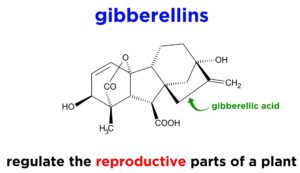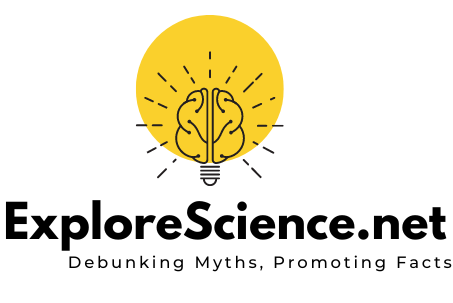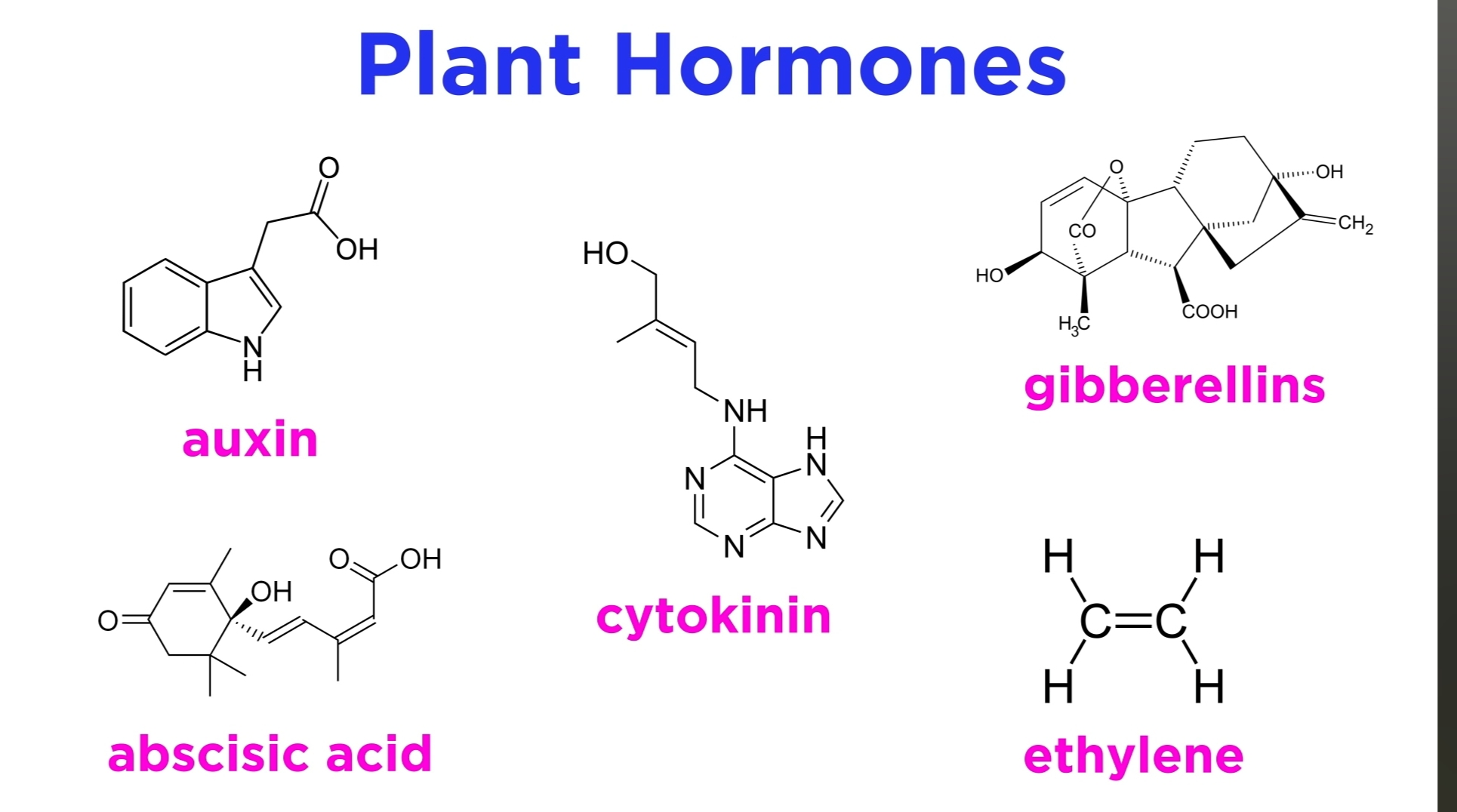
A synopsis of plant hormones and their importance Describe the idea of plant hormones, which are chemical messengers that plants make to control a range of physiological functions. Describe their importance in regulating development, growth, and reactions to stress, gravity, and other environmental cues.Different Plant Hormone
Auxin : Auxins are hormones that stimulate growth towards light, apical dominance (suppression of lateral bud expansion), phototropism (growth towards light), and gravitropism (reaction to gravity).Auxins, both natural and artificial, include synthetic auxins like 2,4-dichlorophenoxyacetic acid (2,4-D) and common auxins like indole-3-acetic acid (IAA).Auxins are frequently employed in tissue culture procedures to encourage the growth of roots in plant cuttings, which facilitates vegetative propagation and clonal plant multiplication.
Gibberellins: Hormones called gibberellins are involved in fruit development, flowering, stem elongation, and seed germination.Gibberellins interact with other hormones to control different elements of plant growth and development, including auxins and cytokinins.In agriculture, gibberellic acid (GA3) is used to increase fruit size and quality in crops like strawberries and grapes, as well as to stimulate stem elongation in seedlings and encourage seed germination.
cytokinins: Cytokinins are hormones that increase shoot growth, postpone senescence (ageing), and encourage cell division. In plant tissues, the antagonistic actions of auxins and cytokinins balance the processes of cell division and elongation.Cytokinins play a critical role in tissue culture procedures, as they encourage the growth of entire plants from tissue cultures and the proliferation of shoots from explants. This makes them essential for plant rejuvenation.
.Acid Abscisic (ABA): ABA is a hormone that controls responses to stress including salinity and drought, as well as seed dormancy and stomatal closure (which stops water loss).part in adapting to and tolerating drought, by controlling water balance, shutting stomata, and turning on stress-responsive genes, ABA aids in the survival and adaptation of plants under drought stress.In order to coordinate physiological processes, ABA signals through a number of routes involving ABA receptors, protein kinases, and transcription factors.
Ethylen: The hormone ethylene controls the ripening of fruit, senescence, or ageing, as well as how the body reacts to mechanical stress and environmental stimuli.Impacts on the development and growth of plants.ethylene controls physiological processes, such as flower and fruit development, leaf abscission, and seed germination, are influenced by ethylene.Fruit ripening and senescence are postponed with the use of ethylene inhibitors, such as 1-methylcyclopropene (1-MCP), which prolongs the fruit and vegetable shelf life during storage and transit.
Application of plant Hormones :
Crop improvement
By controlling a number of growth and developmental processes, plant hormones are essential for enhancing crop output. Hormonal therapies are used by farmers and agricultural researchers to encourage desired qualities including bigger fruits, more flowers, and quicker seed germination.Plant hormones play a role in the activation of defence systems against pathogens, pests, and environmental stresses, hence promoting disease and stress resistance. Scientists are trying to create crop kinds that are more resistant to pests, diseases, drought, salinity, and high temperatures by adjusting hormone levels. To increase drought tolerance, for instance, breeding programmes can concentrate on choosing plants with higher abscisic acid (ABA) levels.
Fruit Ripening
Fruit ripening and senescence are controlled by ethylene, a crucial plant hormone. Growers may synchronise fruit ripening, minimise post-harvest losses, and increase fruit and vegetable shelf life by managing ethylene levels. During storage and transit, methods like ethylene inhibitors and controlled environment storage are used to postpone fruit ripening and preserve product quality.
Gibberellins are essential for encouraging seed germination and breaking seed dormancy, as well as for plant propagation. Gibberellic acid treatments are used by horticulturists to improve seed germination rates and guarantee consistent seedling emergence in both agricultural and horticultural crops. Furthermore, in tissue culture methods, cytokinins are frequently employed to promote root development and shoot proliferation for plant propagation and cloning.
Growth Regulators
The growth and development of plants are mostly controlled by plant hormones. For example, auxins are employed to boost apical dominance in ornamental plants and trees and to encourage root formation in cuttings. Growers can accomplish desired aesthetic and functional objectives in landscaping and ornamental horticulture by controlling plant height, branching patterns, and flowering seasons with growth regulators that contain specific hormones.
Biotechnological Applications: Genetically modified crops with improved features like herbicide tolerance, pest resistance, and increased nutritional content have been developed thanks to biotechnology advancements that have made it possible to manipulate plant hormone pathways for a variety of objectives. Scientists can modify plant growth, stress responses, and yield potential by introducing or suppressing particular hormone-related genes using genetic engineering techniques.
Plant defence
Plant hormones also have an impact on environmental remediation techniques, such as phytoremediation, which uses plants to extract toxins and other contaminants from soil, water, and the atmosphere. A number of hormones, including ethylene and abscisic acid, affect how plants react to pollutants, heavy metals, and other poisons, which makes them useful instruments in the fight against environmental pollution and the rehabilitation of damaged ecosystems.
Research : Plant hormones are vital research instruments for the basic biology, physiology, and ecology of plants. The hormone signalling routes, patterns of gene expression, and hormone interactions driving plant growth and development are studied by researchers using hormone treatments and mutants. Additionally, hormone action examples are used in outreach and educational programmes to highlight important concepts in plant science and agricultural technology.
Role of plant Hormones in tissue culture

Tissue culture, sometimes referred to as micropropagation, is a method for asexually propagating plants in carefully monitored lab settings. Plant hormones are essential because they control the growth and development of plant tissues and organs in tissue culture. Plant hormones benefit tissue culture in the following ways:
Plant tissues, including meristems, explants (leaf, stem, or root segments), or single cells, are grown on a nutritional media that contains particular plant hormones to begin the culture process. The selection and concentration of hormones in the culture media dictate how the tissues develop and differentiate.
Callus formation
 To stimulate the formation of a callus, which is an undifferentiated mass of cells, from the explants, certain ratios of auxins and cytokinins are mixed. Under the right circumstances, totipotent cells found in callus can regenerate into whole plants.Somatic
To stimulate the formation of a callus, which is an undifferentiated mass of cells, from the explants, certain ratios of auxins and cytokinins are mixed. Under the right circumstances, totipotent cells found in callus can regenerate into whole plants.Somatic
Embryogenesis:
In cultured tissues, somatic embryogenesis can be produced by varying the amounts of auxins and cytokinins. Somatic cells in the callus or other explants can give rise to somatic embryos, which are similar to zygotic embryos. These embryos are capable of germination
Shoot Proliferation:
Cytokinins, specifically benzyladenine (BA) and kinetin cytokinin types, promote the explants’ shoot buds to proliferate. Cytokinins stimulate cell division and shoot meristem formation, which results in the growth of many shoots form a plantlet
Root Initiation
To encourage the production of roots in the regenerated shoots, auxins like indole-3-acetic acid (IAA) or indole-3-butyric acid (IBA) are frequently added to the culture media. Plantlets with a functional root system are more easily established when auxins are present to stimulate the initiation and elongation of roots.
Shoot Elongation:
Cytokinins are frequently utilised to encourage shoot elongation and multiplication following the initial round of shoot proliferation. The goal of this step is to create robust, healthy plantlets that can be moved to soil or allowed to acclimatise in a greenhouse.
Hardening: After the plantlets have grown roots and branches, they go through a process called hardening that helps them get acclimated to the light, humidity, and temperature of their surroundings. For plantlets to successfully transfer from in vitro to the ex vitro environment.


Good 👍